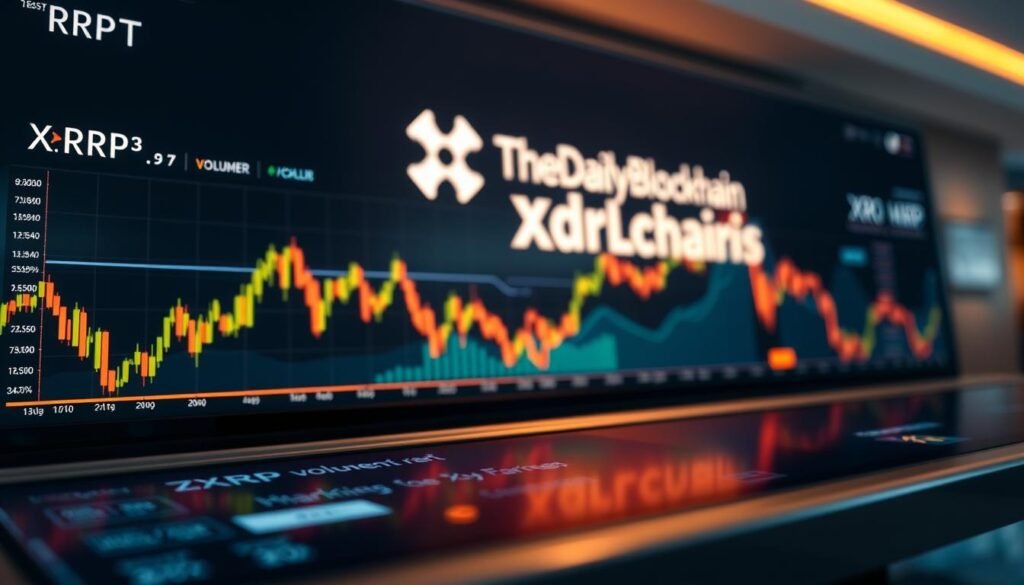Surprising fact: a well-known bitcoin investor publicly sketched a scenario that would lift XRP from about $2.70 to $50 under a “controlled launch,” a claim that has refocused market attention today.
This hub summarizes what matters now: the top headline, the market snapshot, and the regulatory backdrop tied to Ripple’s bid for a U.S. banking license. The piece is built to be quick to scan and easy to follow.
We explain how that $50 thesis links to liquidity, payments rails, and institutional access. You’ll also find clear notes on how spot, perpetuals, and futures can change intraday price action, and how CEX versus DEX activity affects volatility.
Key Takeaways
- Top story: a high-profile thesis outlines a possible controlled run from $2.70 toward $50.
- Ripple’s banking license bid could be a major catalyst for liquidity and institutional access.
- Watch differences across spot, perpetual, and futures venues for price signals.
- Monitor CEX vs DEX flows to gauge intraday volatility and discovery.
- Track credible data sources and dashboards for timely, verifiable indicators.
Top Story Today: Investor Calls for a “Controlled Launch” Toward $50
A high-profile investor laid out a staged plan that could push the token from roughly $2.70 toward $50 if a few structural changes occur.
Why it matters: the thesis ties directly to Ripple’s bid for a U.S. banking license and the idea that regulated banking access could unlock institutional demand.
Ripple’s U.S. banking license bid and what it could mean for the token
The license is framed as a structural unlock. Approval could enable deeper fiat rails, custody services, and settlement workflows that make institutional onboarding easier.
From today’s price to a moonshot: unpacking the $2.70 to $50 thesis
“A controlled launch implies orderly, phased liquidity provisioning tied to bank-grade custody and compliance,” the report states.
- Orderly distribution could reduce wild volatility while building depth.
- Realizing a $50 target needs broad new demand, credible counterparties, and clear regulatory scope.
- Watch fiat on/off ramps, custody setups, and how a bank-chartered model manages liquidity and risk.
XRP Market Snapshot: Price, Volume, and Market Structure Today
Seeing where bids and offers sit on spot, swaps, and dated futures clarifies intraday bias.

Spot, perpetual, and futures: where liquidity is concentrating
Liquidity fragments across spot, perpetual swaps, and dated futures. Track depth on USD, USDT, and USDC pairs to spot where slippage may widen.
CEX vs. DEX activity: how flows are shaping intraday moves
CEX order books often set immediate price levels. DEX pools can reveal retail appetite and longer tail flows.
Watch divergences between the two — they can signal mean reversion or momentum continuation.
CMC Daily Analysis highlights: data points to watch
Use funding rates, open interest, and volume profiles as real-time sentiment gauges. CMC Daily Analysis pages flag breadth and volatility clustering.
Note: some dashboards include affiliate links and disclosures; read methodology notes before drawing conclusions.
Similar coins to XRP: relative strength and correlation
Compare relative performance to similar coins to see if sector-wide flows or idiosyncratic catalysts drive moves.
| Venue | Metric | Signal | Implication |
|---|---|---|---|
| Spot CEX | Order book depth | Thick at USD quotes | Lower slippage, anchored levels |
| Perpetuals | Funding / OI | Positive funding, rising OI | Long bias, caution for squeezes |
| DEX Pools | Swap volume | Retail spikes | Volatility and short-term momentum |
xrp news and Regulatory Landscape: Lawsuit, Securities Questions, and Rules
Court timing and agency guidance are central to how companies manage exposure and compliance. Market participants track filings and public statements to gauge likely paths and timing.
Why this matters: the ongoing lawsuit and classification debates shape listing decisions, custody approaches, and institutional access. A clear set of rules would reduce uncertainty and could widen participation.
Latest developments in the case: potential outcomes and timelines
Possible outcomes include negotiated settlements, judicial rulings, or stepwise guidance from regulators. Each scenario carries a different market impact and timeline.
- Negotiated resolution: could speed certainty but may limit precedents.
- Judicial determination: offers legal clarity but can take longer.
- Regulatory guidance: incremental rules can change compliance costs and product availability.
Securities vs. commodity debate: how classification impacts the market
The securities question affects reporting, custody, and who may sell or hold the asset. A commodity-like classification usually eases some constraints for exchanges and institutional platforms.
Compliance signals from companies and exchanges
Exchanges and financial firms adjust listings, leverage, and geographic access based on perceived risk. Watch public disclosures and product changes as compliance indicators.
| Actor | Signal | Implication | Timing |
|---|---|---|---|
| Exchanges | Listing changes | Access shifts for traders | Near-term |
| Custodians | Policy updates | Institutional onboarding | Rolling |
| Companies | Public filings | Market confidence | Event-driven |
“Follow official dockets and firm disclosures; separate speculation from documented developments.”
Banking, Payments, and Real-World Adoption
If regulated banking ties are put in place, real-world payment flows can become more predictable and auditable. This matters for firms weighing pilot projects and full production launches.
Ripple’s company roadmap: banking integrations and payment corridors
Banking access could allow direct settlement, stronger custody, and simpler fiat on/off ramps. That structure helps lower transaction costs and supports stable liquidity in corridors that use the asset.
Institutional interest: enterprise pilots, partnerships, and activity
Companies evaluate pilots by total cost, vendor resilience, and reporting. Licensed banking links increase confidence for treasury teams and third‑party payment providers.
- What to watch: sandbox programs, public reference clients, and phased rollouts that prove throughput.
- Clear governance, standardized APIs, and risk controls attract institutional demand.
- Durable adoption depends on uptime, audited processes, and service‑level commitments aligned to banking standards.
“A bank‑chartered approach can bridge compliance expectations and operational needs for payments at scale.”
Technical Levels: Resistance, Support, and Options Positioning
Traders combine on‑chain cues, order book maps, and derivatives flow to build a clear view of where the market may stall or accelerate. This section outlines how to read those signals and apply them to trading plans today.
Key resistance zones traders are watching
Resistance is often defined by clusters of past swing highs and high‑volume nodes. When multiple timeframes show the same zone, traders treat it as a likely cap for rallies.
Support mapping joins horizontal levels with moving averages and liquidity footprints from heatmaps. These overlays reveal where buyers may absorb selling pressure or where stop runs are likely.
Options data: skew, open interest, and implied volatility
Options metrics help translate derivative demand into probability maps.
- Skew compares call vs. put pricing; rising call skew near resistance can hint at upside attempts.
- Open interest concentrations create expiry magnets; clustered strikes often shape intraday activity as dealers hedge.
- Implied volatility above realized volatility signals rich optionality and influences whether traders prefer spreads or outright buys.
“Read resistance in context — low liquidity tests often wick, while broad participation raises the odds of a clean breakout.”
Use this framework to interpret price moves for xrp without relying on fixed levels. Combine chart structure with options flow to make data‑aware decisions and manage risk around likely rejection or breakout points.
Data Download: On-Chain Metrics, Market Breadth, and Yield
Watch throughput and wallet activity to tell if network adoption is keeping pace with price moves. Short-term spikes in transactions can reflect trading, while sustained growth usually shows real usage.
Network activity and transactions: reading the tape
Key metrics include transaction counts, throughput, and fee dynamics. These help show whether demand for the token is usage-driven or speculative.
Market breadth matters too — compare advancing versus declining coins to see if moves are sector-wide or idiosyncratic.
XRP Yield: opportunities, risks, and platform considerations
Yield options include lending, liquidity provision, or staking-like programs. Each offers varying APRs and different counterparty exposure.
| Yield Type | Typical Source | Key Risk | Suitability |
|---|---|---|---|
| Lending | Borrower demand | Counterparty default | Short-term liquidity |
| Liquidity pools | Swap fees + incentives | Impermanent loss | Active management |
| Staking-like | Protocol rewards | Lockups & smart contract | Longer horizon |
Practical checklist: verify custody model, insurance, jurisdiction, and audited disclosures before committing capital. Compare xrp coins to similar coins to judge whether yields are competitive or reflect higher risk premia.
“Always review affiliate disclosures and methodology notes on dashboards before committing capital.”
Conclusion
This roundup closes by separating lasting market signals from headline-driven chatter. Today’s dominant theme — the controlled launch thesis toward $50 — depends on regulatory progress and bank-grade integrations by the company backing the token.
Track official filings and the ongoing lawsuit for any ruling or change in classification that could alter the likely outcome. Use spot, perpetual, and futures data plus CEX/DEX flows to read real liquidity shifts.
Monitor resistance behavior and options skew for short-term positioning. Assess adoption through transaction utility and corridor performance before treating yields or pools as a lasting play.
For deeper work, follow primary sources and use verified links on dashboards. Compare xrp coins to broader coins to see if moves are idiosyncratic or sector-wide.
FAQ
What is the latest on Ripple’s bid for a U.S. banking license and why does it matter?
Ripple’s application for a U.S. banking charter aims to let the firm offer custody, payments, and settlement services under federal supervision. If approved, the company could deepen ties with banks, speed cross-border transfers, and move more tokens into regulated custody — a development that often reduces market uncertainty and can attract institutional capital.
How realistic is the “controlled launch” narrative that targets a move from .70 to ?
The thesis rests on a mix of factors: broad adoption in payments rails, favorable regulatory rulings, and sustained liquidity from exchanges and OTC desks. While controlled rollouts by major partners could lift demand, reaching requires dramatic increases in use and capital inflows. Traders should weigh fundamentals, on-chain activity, and macro liquidity before treating such targets as likely.
Where is liquidity concentrating across spot, perpetual, and futures markets today?
Liquidity tends to gather where derivatives offer tight spreads and depth — major centralized exchanges for spot and perpetuals, and regulated futures venues for listed contracts. Intraday concentration shifts with news, funding rate divergences, and headline-driven flows, so monitor order book depth and funding metrics to see where price pressure may form.
How do centralized exchange (CEX) flows compare with decentralized exchange (DEX) activity in shaping price moves?
CEX flows often drive large, rapid moves because they handle higher volume and institutional orders. DEX volumes can reflect retail sentiment and on-chain movement, but gas costs and slippage limit large trades. Watch net inflows/outflows to custodial wallets and DEX swap volumes to understand the balance between institutional and retail pressure.
Which daily data points from aggregators should traders watch this session?
Key metrics include price change, 24h volume, exchange net flows, funding rates, open interest across maturities, and correlation with major tokens. CoinMarketCap-style daily snapshots and exchange reports can highlight liquidity shifts, while order book snapshots reveal immediate resistance and support levels.
What similar tokens should investors compare for relative strength and correlation?
Compare to other payments-focused or high-liquidity assets such as Litecoin and Stellar for payment use cases, and broad-cap tokens like Bitcoin and Ethereum for macro correlation. Look at short-term beta and correlation matrices to see if the token is moving with alt-market trends or following idiosyncratic drivers.
What are the latest milestones in the ongoing lawsuit and possible timelines?
The case has progressed through discovery and several significant rulings. Potential outcomes range from settlements to clarified regulatory guidance. Timelines depend on court schedules, appeals, and settlement talks — expect material updates on motions and rulings that can quickly affect market sentiment.
How would a securities vs. commodity classification affect the market and institutions?
A securities designation could limit trading listings, increase compliance burdens, and restrict some firms from offering custody or trading. A commodity label typically permits broader market access and clearer rules for exchanges and service providers. Classification shapes institutional willingness to onboard the asset.
What compliance signals from companies and exchanges matter most right now?
Watch for delistings or relistings, changes to custody policies, enhanced KYC/AML steps, and public statements from major exchanges and payment partners. Those actions reveal how firms interpret regulatory risk and can alter liquidity and retail access quickly.
How is Ripple pursuing real-world payments and banking integrations?
The company pursues partnerships with banks and payment providers to enable faster settlement corridors and cross-border corridors. Pilot projects and APIs that reduce FX friction are central to adoption, and announced integrations often coincide with upticks in on-chain activity and partner-led volume.
What signs indicate growing institutional interest and enterprise activity?
Institutional interest shows up as custody arrangements, OTC block trades, API integrations by payment firms, and public pilot disclosures. Increased open interest, larger order book sizes, and primary-market sales also signal higher institutional engagement.
Which technical resistance and support zones are traders monitoring now?
Traders focus on recent swing highs and lows, volume-weighted price areas, and option-derived strike clusters. Resistance typically aligns with prior consolidation peaks, while support sits near recent demand zones and high-volume nodes. Use intraday order book and historical range levels for precise entries.
What can options data tell about market bias — skew, open interest, and implied volatility?
Put-call skew shows tail risk pricing, while open interest reveals where large positions could amplify moves at expiries. Rising implied volatility often precedes big moves and increases premium costs for hedging. Monitor concentrated strikes and changes in skew to infer directional bets.
Which on-chain metrics give the clearest signal of network health and adoption?
Key metrics include active addresses, transaction count, average transaction value, and token age distribution. Rising active addresses and transaction throughput suggest real usage, while spikes in large transfers can indicate whale movement or exchange flows that affect liquidity.
Are there yield opportunities tied to the network, and what risks should investors consider?
Yield appears via lending platforms, staking-like programs on custodial services, or liquidity provision on DeFi rails. Risks include smart contract vulnerabilities, counterparty failure, and regulatory changes that can freeze or restrict platforms. Evaluate platform audits, custodial security, and withdrawal terms before committing funds.
How should retail traders balance regulatory headlines with technical signals?
Combine headline monitoring with confirmed technical setups. Regulatory news can create gaps and trend changes, so use defined risk (stop-losses) and size positions according to volatility. Treat legal and compliance updates as catalysts rather than sole trade triggers.



